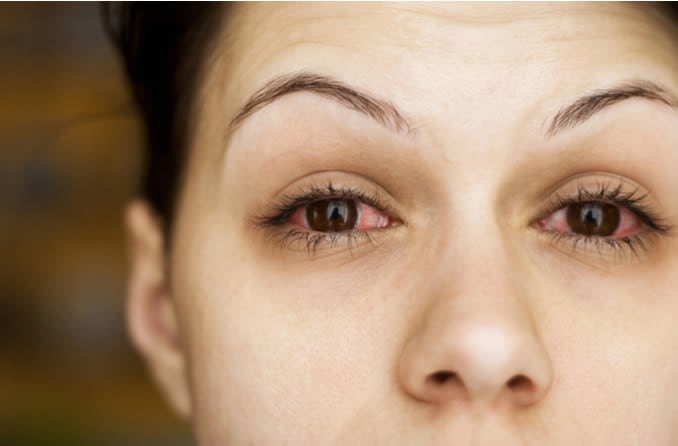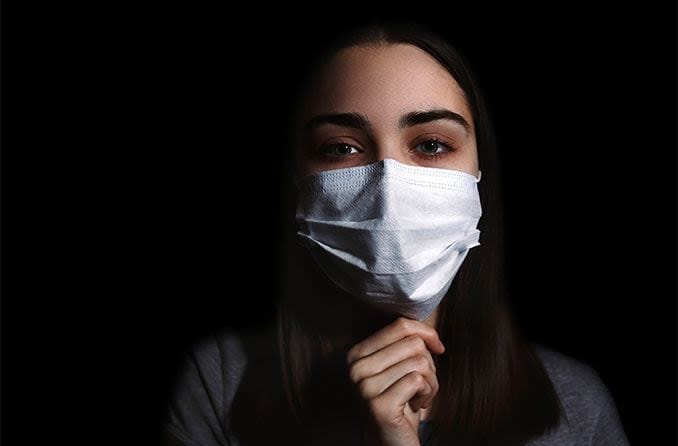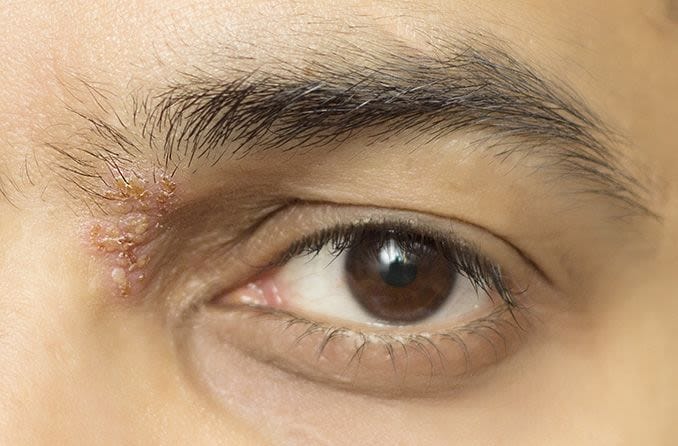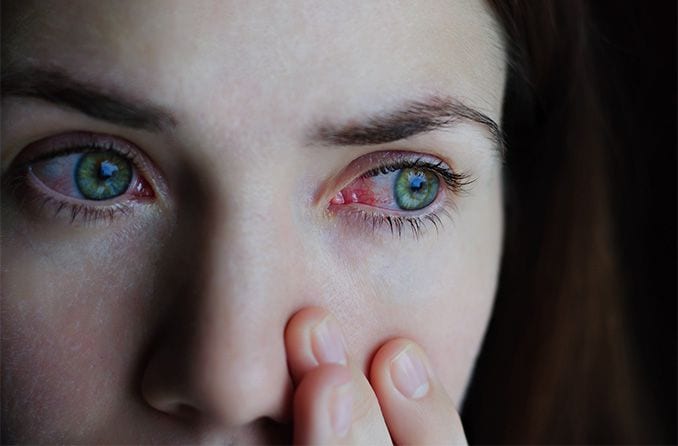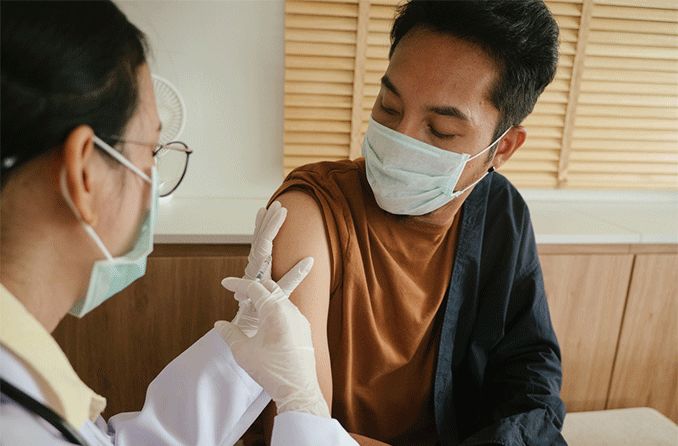Can COVID-19, a cold or the flu cause conjunctivitis?
Pink eye can be a symptom of viral illnesses such as COVID-19, a cold or the flu — but it doesn't happen every time.
If you have a hacking cough, runny nose, or other symptoms of a viral illness, and your eyes get red and weepy and your eyelids puffy, you could have viral pink eye. The medical name for pink eye is conjunctivitis .
How can this happen? If you’re sick, you may transfer viruses to your eye by blowing your nose then wiping away a tear or simply touching the area around your eye.
How COVID-19 relates to pink eye
The novel coronavirus, which causes a disease known as COVID-19, is a virus first seen in humans in an outbreak that began in late December 2019 in China. The World Health Organization declared COVID-19 a pandemic on March 11, 2020.
Coronavirus can cause pink eye, according to the American Academy of Ophthalmology (AAO), but the chances are low.
"It might be possible for coronavirus to cause a pink eye infection (conjunctivitis), but this is rare," the AAO states.
SEE RELATED: Coronavirus: How eyes may play a role in its spread
There are two main ways the new coronavirus and other viruses could get into the eye and possibly cause conjunctivitis:
1. Coughs and sneezes
First, the coronavirus could get into the eye through aerosol transfer. “That’s if you’re standing within six feet of someone who has the virus, and they cough or sneeze, and you aren’t wearing any protective eyewear,” says Stephanie Marioneaux, MD, clinical spokeswoman for the AAO.
2. Touching the eyes
The coronavirus also could be transferred from the hands to the eyes. For example, you could get coronavirus in your eye if someone with the virus touches a grocery store cart handle, then you use the same cart and touch your eyes, Marioneaux says.
The good news is that only about 1% to 3% of coronavirus patients get conjunctivitis, according to the AAO.
Adenovirus conjunctivitis: The most common type
Coronavirus is still front and center since 2020, but you may not have heard of the most common cause of viral pink eye: adenoviruses.
The symptoms of adenovirus infection can resemble a cold or the flu and may include:
Fever
Gastrointestinal symptoms such as diarrhea and nausea
Inflammation of airways and lungs, known as acute bronchitis
Sore throat
Pneumonia
Pink eye
Conjunctivitis symptoms typically involve a red, infected eye, a watery discharge and a sandy, gritty feeling in the eye.
Adenoviruses are the group of viruses that cause the common cold and many other common upper respiratory conditions.
An adenovirus can be the cause of a mild conjunctivitis with no other symptoms or be the cause of the most serious form of conjunctivitis known as epidemic keratoconjunctivitis (EKC). This particular type of conjunctivitis tends to occur in clusters and is highly contagious and uncomfortable.
Adenoviruses can live on surfaces for a long time, Marioneaux says. “They can last on a doorknob for 30 days and still be just as infectious as on day one,” she says.
There also are many other viruses, and strains of viruses, that can cause conjunctivitis.
Can the flu cause pink eye?
Some strains of the flu may cause conjunctivitis. However, it’s not nearly as common a cause as adenovirus, Marioneaux says.
How can you prevent viral conjunctivitis in your eyes?
Prevention is the best medicine. Here are four ways to reduce your chances of getting viral conjunctivitis:
1. Wash your hands the right way
Review the five steps to washing hands correctly from the U.S. Centers for Disease Control and Prevention (CDC). You must wet your hands, turn off the tap, apply soap, lather and scrub for 20 seconds, then rinse. After washing your hands, air dry them or use a clean towel.
2. Don’t touch your eyes
Resist the urge to dab, rub or wipe your eyes, or touch other parts of your face, whether or not you have symptoms of illness right now. “Do not touch your eyes unless you use a clean tissue,” Marioneaux says.
3. Avoid sharing personal items
Don't share items such as contact cases, eye drops, face makeup or makeup brushes, pillowcases, or bath or hand towels, the CDC recommends. Conjunctivitis is very contagious a patient can cause the spread from one eye to the other.
4. Switch from contacts to glasses
Contact lens wearers may want to switch to eyeglasses temporarily. “Many contact lens patients touch their eyes without even thinking about it,” Marioneaux says. “So maybe wear glasses until the coronavirus scare is over.”
It’s hard to overstate the importance of good hygiene practices.
“You just never know what your hands have come in contact with when you touched the doorknob, used the pencil or signed the credit card box behind customer number 1,000,” Marioneaux says.
READ MORE: Eye germs and viruses: Keeping hands, glasses and contacts clean
Viral conjunctivitis treatment: What you should know
There is no treatment for viral pink eye, but it typically goes away on its own in one to two weeks.
If you’re diagnosed with viral conjunctivitis, your eye doctor may recommend these home remedies for pink eye to help ease your symptoms:
Take an over-the-counter pain medication to ease any discomfort.
Put a warm compress on your eye for a few minutes, using a clean wash cloth each time and a different wash cloth for each eye to avoid transfer of the condition from one eye to the other.
Use lubricating eye drops , also known as “artificial tears,” to soothe the irritated eye. Be careful not to touch the tip of the bottle to your eye so you don’t spread the infection.
You should know that it’s common for health care providers to incorrectly prescribe antibiotic eye drops for viral pink eye, especially if you go to a family doctor or urgent care provider who may have little experience with differentiating eye infections.
In fact, one study of antibiotic use for pink eye found that most people with acute conjunctivitis are getting the wrong treatment. The study found that 60% of patients get prescribed antibiotics even though these drugs are usually not necessary.
It is often the patient or parent who assumes that a typical viral conjunctivitis will not resolve without the aid of a topical medication and may even pressure a practitioner into prescribing one. This is an incorrect assumption.
This is a problem for two big reasons:
1. Incorrect antibiotic use can cause resistance
If a patient is given an antibiotic unnecessarily, it may be less effective in the future for treating a more serious eye infections, Marioneaux says. “Patients who don’t need antibiotics are being given medications we reserve for our toughest cases.”
2. Antibiotics may make viral pink eye worse
Antibiotic eye drops can interfere with your body’s immune response, which is what ultimately gets rid of viral conjunctivitis, Marioneaux says. If this happens, healing can be delayed.
It’s important to get correctly diagnosed by a vision care provider to avoid incorrect treatment and get the proper diagnosis, education and plan. It may be difficult to distinguish viral conjunctivitis caused by adenovirus from other eye infections caused by a variety of viruses or bacteria.
A red eye could have a variety of causes, Marioneaux says.
What to do if you’re sick and have eye symptoms
What if you come down with a fever, sniffles or other symptoms and develop what looks like pink eye?
“Avoid any kind of DIY diagnosis,” Marioneaux says, adding that eye redness, even while you’re sick, doesn’t necessarily mean you have an infection.
For example, irritation, redness or swelling could be caused by allergies , antihistamines, cough medicine or other medications that dry out your sinuses and may cause dry eyes too.
That’s why it’s important to consult an eye care professional to find out what’s really going on with your eyes, Marioneaux says.
And with the ongoing COVID-19 pandemic, it’s more important than ever to take precautions not to spread viruses.
Here’s what to do if you have an eye issue and also have a fever, cough, shortness of breath or any other symptoms of illness:
Put off non-urgent appointments
If you have a routine eye exam scheduled, postpone your visit to the eye doctor until you are well.
See an eye care professional
Don’t get treatment for a medical eye problem from a family doctor or urgent care center practitioner. Optometrists and ophthalmologists specialize in issues involving the eye therefore have more experience in diagnosing and treating these conditions.
Call your eye doctor before you visit
Call your eye doctor’s office to describe your symptoms and discuss your eye problem before going into the office. Tell your doctor if you have symptoms of COVID-19 or think you may have been exposed.
If you are sick and have an urgent eye problem that requires in-person attention, your doctor should ask you to wear a face mask and sit in a separate waiting area away from other patients.
Your eye doctor may use protective gear such as eye goggles, a face mask, gown, gloves and a slit lamp breath shield while examining you.
What to do if you think you have pink eye
Viral conjunctivitis is self-limiting, the symptoms involved typically last 7-10 days. It is most contagious during the first three to four days after the onset of pink eye.
Avoid sharing items with others and touching the eye during the entire course of the condition. See your eye doctor to help you determine the cause of your conjunctivitis and develop the best treatment and plan.
